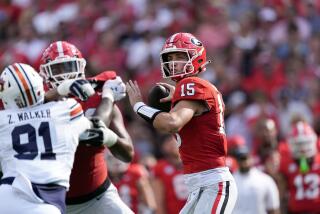NCAA, Bat Makers Reach a Resolution
The college baseball bat saga took a turn toward resolution Tuesday.
The NCAA Championship Cabinet approved using new bat standards for the 1999 playoffs and College World Series, but recommended eliminating a requirement that had concerned aluminum bat manufacturers and left coaches uncertain about which bats to use in the upcoming season.
Not included in the proposed specifications is a standard that would have limited the initial velocity of a batted ball to 93 mph.
Final approval will be needed by the NCAA Executive Committee because the Division II and Division III championship committees already had approved the speed restriction.
“This looks like a compromise, and it seems to be a good one,” Cal State Fullerton baseball Coach George Horton said.
The Pacific 10 Conference approved, in general, those same standards for non-wood bats for the regular season, pending approval by its presidents. The Big West Conference will discuss the issue in a conference call among athletic directors on Thursday, but is expected to follow suit.
Confusion has reigned since the NCAA raised new questions in August about player safety, as well as the legal liability of using high-tech metal bats in the 1999 season.
The Division I baseball committee reacted by recommending that the new standards go into effect earlier than Aug. 1, 1999, the date originally set. The rules committee had pushed for limits on the high-powered bats to restore better balance between offense and defense, as well as for player safety.
Jean Lenti Ponsetto, chair of the Championship Cabinet, said the baseball committee made a new recommendation eliminating the requirement limiting speed.
“We decided not to put the exit speed requirement in place at this time because of the slowness in setting up the testing,” Ponsetto said.
Richard Rockwell, chairman of the Division I baseball committee, said he made the new proposal based on a recommendation from the rules committee and an official of the American Baseball Coaches Assn.
“Our first priority was the student-athlete’s welfare,” Ponsetto said. “I think the standards we set will be acceptable to all Division I conferences, and I think it will be acceptable to the bat manufacturers.”
Jim Easton, chairman of Easton Sports, which makes aluminum bats and is suing the NCAA for restraint of trade, said in a statement that he was encouraged by the recommendation.
“Easton has a bat that meets the Division I recommendation without the previously proposed unrealistic exit speed and stands ready to make bats available to consumers.”
Marty Archer, president of the Louisville Slugger division of Hillerich & Bradsby, was not available for comment Tuesday, but he had said earlier he was concerned about the original exit speed requirement because of the uncertainty involved with testing procedures.
Archer and Easton have said that some wooden bats have exit speeds greater than 93 mph.
Horton said he was assured Tuesday by a representative of Louisville Slugger that his team would be provided some metal bats that meet the NCAA standards for the start of preseason practice in January and additional bats in time for the start of the season in February.
Pac-10 Commissioner Tom Hansen said the Pac-10 will require manufacturers of non-wood bats used by conference teams to provide “a defense and indemnification from lawsuits.”
More to Read
Go beyond the scoreboard
Get the latest on L.A.'s teams in the daily Sports Report newsletter.
You may occasionally receive promotional content from the Los Angeles Times.










